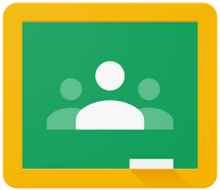Google Classroom
Google Classroom ( . English for "Google classroom") is an Internet platform that teachers allows the school day, learning and exercises and tasks to create for performance records into paperless way and hand out to the students; The students work on the tasks on the computer (either as homework or in assigned working hours during the school day), can communicate electronically with the teacher in the event of any problems or queries and submit them electronically to the teacher after completion. Google Classroom is thus an instrument for integrated learning .
Google LLC put the platform into service on August 12, 2014 as part of its Google for Education service. Google Classroom is available in 42 languages, including German. In the United States , Google Classroom is already used on a very large scale, while it is still little known in the German-speaking world.
requirements
The use of Google Classroom is free of charge. Teachers who want to use the service need the support of their school, which must have set up a G-Suite-for-Education account. Google will only set up such an account for applicants who meet certain requirements. In schools in the United States, this role is often performed by a school IT administrator ; However, special IT expertise is not required either to set up the G Suite for Education account or to use Google Classroom. As soon as the G Suite for Education account exists, interested teachers can set up virtual classes and use the services as they wish.
Services
elements
Google Classroom bundles some of Google's services specifically for use in school lessons.
Documents
The documents that students and teachers create and share with each other in Google Classroom are managed under Google Drive . Google Drive is a file hosting service from Google that uses Google Docs, Sheets, Slides and Forms to create text documents , tables , presentations and electronic forms and to store them in the cloud - not on the user's computer, but on a Google - Server - supported.
communication
Google 's email service Gmail can be used for communication between teachers and students . However, this is not mandatory; some schools even prohibit the use of Gmail entirely. As an alternative, threads are available (“stream”) that can be used not only for placing regular teacher contributions, but also for communication, for internal-public communication as well as for private ones, which only the teacher and the respective student can see can.
Parents have the option, if the participating teachers arrange this, to have information about current teaching activities and tasks of their child sent to them by email either daily or weekly. Teachers can also use this channel to address parents directly, e.g. B. when donations in kind are needed for individual projects or teaching activities. Compared to conventional teacher → parent emails, these “summary emails” have the advantage for parents that they receive information from all teachers who use Google Classroom in a single email.
In the United States, teachers generally have business email addresses that allow students and parents to reach into their classroom even when they are not using Google Classroom.
time planning
The Google Calendar can be integrated and used to manage appointments and deadlines .
Functions
Participant administration
To invite students to a virtual class, the teacher provides them with a code that they can use to log in . With the help of this code, the students can then identify themselves on the website classroom.google.com and gain access. If necessary, parents can also be invited by email to access the virtual classes or parts of them.
Stream
The central element of every virtual class is the “stream”, a page that offers a thread like in a web forum . The teacher posting here regularly posts such. B. Announcements or tasks. If he so wishes, he can give the students permission to post comments or even their own contributions, either publicly or privately, i. H. so that other students cannot read them. Private comments usually contain questions if a student has problems with the assignment; Public comments are recommended, for example, when the teacher forgot to add important information to an assignment or contribution. Documents, hyperlinks , links to YouTube videos and other things can be attached to all posts if necessary .
App
Google Classroom is also available as an app and enables students to use their mobile phones to see which homework and other tasks are due and which deadlines.
criticism
Google Education is ad-free. Ever since Google in the United States came under massive public and legal pressure because of its practice of scanning private e-mails for market research purposes, e-mails sent as part of Google Classroom have been considered safe from such scanning.
Web links
- We introduce: Classroom - Google for Education
- The teacher reads along. Retrieved on December 17, 2016 (FAZ, December 17, 2016).
Instructional videos for using Google Classroom:
- Google Classroom Tutorial 2015. Retrieved December 14, 2016 (Introduction).
- Google Classroom basics. Retrieved December 17, 2016 (set up classes, grant access to students, share documents).
- Google Classroom: Set tasks. Retrieved December 17, 2016 .
Individual evidence
- ↑ More teaching, Less tech-ing: Google Classroom Launches Today. Retrieved December 17, 2016 .
- ↑ Get started with G Suite for Education. Retrieved December 17, 2016 .
- ↑ Register and get started. Retrieved December 17, 2016 .
- ↑ About Classroom. Retrieved December 17, 2016 .
- ↑ Google Faces New Privacy Class Claims Over Email Scanning. Retrieved December 17, 2016 .
- ↑ Google Stops Mining Education Gmail And Google Apps Accounts For Ad Targeting. Retrieved December 17, 2016 .

